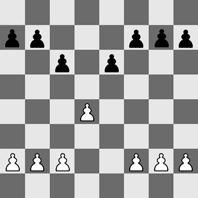 Caro formation Caro formationOpenings: Primary: Caro-Kann. Other: French, Scandinavian, QGD. Character: Slow-paced game. Themes for White: Outpost on e5, kingside space advantage, d4-d5 break, possibility of queenside majority in the endgame (typically after the exchange of White’s d pawn for Black’s c pawn). Themes for Black: Weakness of the d4 pawn, c6-c5 and e6-e5 breaks. The latter break is usually preferable, but harder for Black to achieve. |
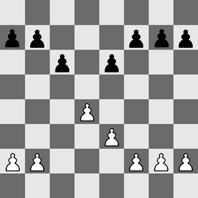 Slav formation Slav formationOpenings: Primary: Slav. Other: Catalan, Grunfeld, Colle system (with colors reversed). Character: Slow-paced game. Themes for White: Pressure on the c file, weakness of Black’s c pawn (either after Black’s b7-b5 or after d4-d5xc6 in response to e6-e5), the d4-d5 break. Themes for Black: e6-e5 and c6-c5 breaks. |
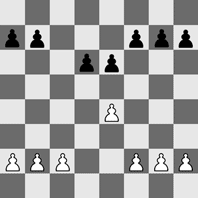 Sicilian – Scheveningen Sicilian – ScheveningenOpenings: Primary: Sicilian (Najdorf, Richter-Rauzer and Sozin variations), Sicilian Scheveningen, and several other Sicilian variations. Character: Complex, dynamic, sharp middlegame. Themes for White: Pressure on the d file, space advantage, e4-e5 break (often prepared with f2-f4), f2-f4-f5 push, g2-g4-g5 blitz (see Keres attack). Themes for Black: Pressure on the c file, minority attack (and counterplay in general) on the queenside, pressure on White’s pawn on e4 or e5, d6-d5 break, e6-e5 transposing into the Boleslavsky hole (see below). It is often unwise for White to exchange a piece on c6 allowing the recapture bxc6, because the phalanx of Black’s center pawns becomes very strong. |
 Sicilian – Dragon Sicilian – DragonOpenings: Primary: Sicilian Dragon. Other: English Opening (with colours reversed). Character: Either a razor sharp middlegame with opposite side castling or a moderately sharp game with same side castling. The Sicilian Dragon requires a high level of opening memorization to play properly. This is especially true when it comes to the Yugoslav Attack in which White plays the moves Be3, f3, Qd2 and 0-0-0. Other variations are: The Classical Dragon where White plays Be2 and 0-0; The Tal attack is defined by Bc4 and 0-0, and the Fianchetto Defense where White plays g3, Bg2 and 0-0. These less common variations lead to less tactical positions, with a potentially technical endgame. Themes for White: Outpost on d5, kingside attack (either f2-f4-f5 with kingside castling or h2-h4-h5) with queenside castling, weakness of Black’s queenside minority (of pawns) in the endgame. Themes for Black: Pressure on the long diagonal, queenside counterplay, exploiting White’s often overextended kingside pawns in the endgame. |
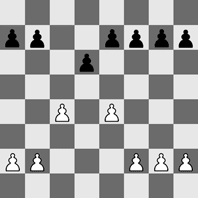 Sicilian – Maróczy bind Sicilian – Maróczy bindMain article: Maróczy bind Openings: Primary: Sicilian. Character: Semi-open game. Themes for White: Nd4-c2-e3, Fianchettoing one or both Bishops, the Maróczy hop (Nc3-d5 followed by e4xd5 with terrific pressure on the e-file), kingside attack, c4-c5 and e4-e5 breaks. Themes for Black: b7-b5 break, f7-f5 break (especially with a fianchettoed King bishop), d6-d5 break (prepared with e7-e6). The Maróczy bind, named after Géza Maróczy, has a fearsome reputation. Chess masters once believed that allowing the bind as Black always gave White a significant advantage. Indeed, if Black does not quickly make a pawn break, his pieces will suffocate to death. Conversely, the formation takes time to set up and limits the activity of White’s light-squared bishop, which can buy Black some breathing room to accomplish this break. |
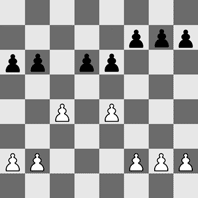 Hedgehog HedgehogOpenings: Primary: English Opening (symmetrical), Sicilian. Character: Closed, Semi-open game. The Hedgehog is a formation similar to the Maróczy bind, and shares the strategic ideas with that formation. |
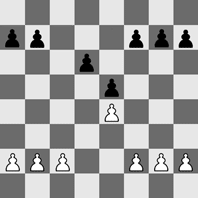 Sicilian – Boleslavsky hole Sicilian – Boleslavsky holeOpenings: Primary: Sicilian Najdorf, Classical, Sveshnikov, Kalashnikov. Other: Sicilian O’Kelly (2… a6). Character: Open, dynamic game. Themes for White: taking control the d5 hole, exploiting the backward d6 pawn, f2-f4 break. Themes for Black: d6-d5 break, queenside minority attack, the c4 square. It is a paradoxical idea that Black can strive for equality by voluntarily creating a hole on d5. The entire game revolves around control of the d5 square. Black must play very carefully or White will place a knight on d5 and obtain a commanding positional advantage. Black almost always equalizes, and might even obtain a slight edge, if the d6-d5 break can be made. Black has two options for his queen bishop: on e6 and on b7 (after a7-a6 and b7-b5). Unusually for an open formation, bishops become inferior to knights because of the overarching importance of d5: White will often exchange Bg5xf6, and Black usually prefers to give up his queen bishop rather than a knight in exchange for a white knight if it gets to d5. When white castles queenside, Black often delays castling because his king is quite safe in the center. |
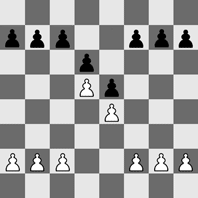 d5 chain d5 chainOpenings: Primary: King’s Indian. Other – Benoni, Ruy Lopez Character: Closed game with opposite side activity. Themes for White: Massive queenside space advantage, c2-c4-c5 break (optionally prepared with b2-b4), prophylaxis with g2-g4 (after f2-f3), f2-f4 break. Themes for Black: kingside attack, f7-f5 break, g7-g5-g4 break (after f2-f3), c7-c6 break, prophylaxis with c6-c5 or c7-c5 transposing to a Full Benoni formation. The chain arises from a variety of openings but most commonly in the heavily analyzed King’s Indian Classical variation. The theme is a race for a breakthrough on opposite flanks – Black must try to whip up a kingside attack before White’s heavy pieces penetrate with devastating effect on the c-file. The position was thought to strongly favour White until a seminal game (Taimanov-Najdorf 1953) where Black introduced the maneuver Rf8-f7, Bg7-f8, Rf7-g7. When the chain arises in the Ruy Lopez, play is much slower with tempo being of little value and featuring piece maneuvering by both sides, Black focusing on the c7-c6 break and White often trying to play on the kingside with the f2-f4 break. |
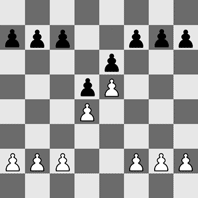 e5 chain e5 chainOpenings: Primary: French. Character: Closed/semi-open but sharp game. Themes for White: kingside mating attack, f2-f4-f5 break. Themes for Black: Exchanging the hemmed-in QB, c7-c5 and f7-f6 breaks. Due to White’s kingside space advantage and development advantage, Black must generate counterplay or be mated. Novices often lose to the sparkling Greek gift sacrifice. Attacking the head of the pawn chain with f7-f6 is seen as frequently as attacking its base, because it is harder for white to defend the head of the chain than in the d5 chain. In response to exf6, Black accepts a backward e6 pawn in exchange for freeing his position (the b8-h2 diagonal and the semi-open f-file) and the possibility of a further e6-e5 break. If White exchanges with d4xc5 it is called the Wedge formation. White gets an outpost on d4 and the possibility of exploiting the dark squares while Black gets an overextended e5 pawn to work on. |
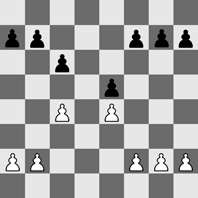 King’s Indian – Rauzer formation King’s Indian – Rauzer formationOpenings: Primary: King’s Indian, Old Indian (colors reversed), Ruy Lopez. Other: Ruy Lopez (colors reversed). The notation in the rest of this section refers to the colors reversed version. Character: Semi-open game. Themes for White: d6 weakness, c4-c5 push, a3-f8 diagonal, queenside pawn storm. Themes for Black: d4 weakness, a1-h8 diagonal, f4 square, kingside attack, trading pieces for a superior endgame. The Rauzer formation is named after Rauzer who introduced it in the Ruy Lopez. It can also rarely occur in the Ruy Lopez with colors reversed. It is considered to give Black excellent chances because d6 is much less of a hole than White’s d4. If the black king’s bishop is fianchettoed it is common to see it undeveloped to f8 to control the vital c5 and d6 squares, or remove White’s dark-squared bishop, the guardian of the hole. The Rauzer formation is often misjudged by beginners. In the position on the left, White appears to have a development lead while Black’s position appears to be riddled with holes. In reality, it is Black who stands clearly better, because White has no real way to improve his position while Black can improve by exploiting the d4 square |
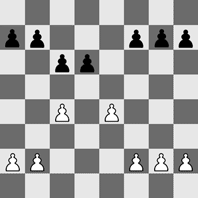 King’s Indian – Boleslavsky Wall King’s Indian – Boleslavsky WallOpenings: Primary: King’s Indian. Other: English, Pirc, Ruy Lopez. Character: Semi-open game, slow buildup. Themes for White: exploitation of d6 weakness, e4-e5 and c4-c5 breaks, minority attack with b2-b4-b5. Themes for Black: attacking the e4 and c4 pawns, d6-d5 and f7-f5 breaks, queenside play with a7-a5-a4. The wall is yet another structure that leaves Black with a d-pawn weakness, but prevents White from taking control of the center and gives Black active piece play and an opportunity to play on either side of the board. |
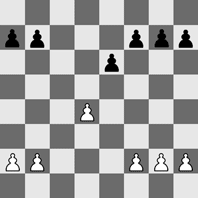 Queen’s Gambit – Isolani Queen’s Gambit – IsolaniOpenings: Primary: Queen’s Gambit. Other: French. Character: Open game. Themes for White: d4-d5 break, sacrifice of the isolani, outpost on e5, kingside attack. Themes for Black: Blockading the isolani, trading pieces for a favorable endgame. |
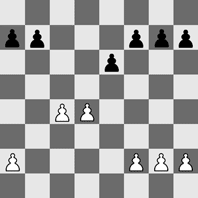 Queen’s Gambit – hanging pawns Queen’s Gambit – hanging pawnsOpenings: Primary: Queen’s Gambit Declined. Other: Queen’s Indian Defense. Character: Open game. Themes for White: Line opening advance in the center, kingside attack. Themes for Black: Forcing a pawn advance and blockading the pair, conversion to isolani. Like the isolani, the hanging pawns are a structural weakness and must not be entered into unless the piece position offers some compensation. The play revolves around Black trying to force one of the pawns to advance. If Black can establish a permanent blockade the game is positionally won. On the other hand, White aims to keep the pawns hanging, trying to generate a kingside attack leveraging off of their superior center control. Other themes for White include tactical possibilities and line opening breaks in the center. |
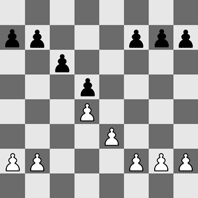 Queen’s Gambit – Orthodox Exchange Queen’s Gambit – Orthodox ExchangeOpenings: Primary: Queen’s Gambit Declined. Other: Caro-Kann (colors reversed). Character: Semi-open game. Themes for White: Minority attack, e3-e4 break. Themes for Black: e4 outpost, kingside attack. |
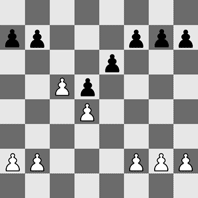 Panov formation Panov formationOpenings: Primary: Queen’s Gambit Declined, Caro-Kann. Other: Alekhine Defense, QGD Tarrasch Defense (colors reversed). Character: Semi-open, dynamic game. Themes for White: Exploiting the dark squares, d6 outpost; queenside majority in the endgame, with an advanced pawn. Themes for Black: e4 outpost, kingside attack, White’s overextended pawn, e6-e5 and b7-b5 breaks. |
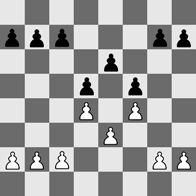 Stonewall formation[edit] Stonewall formation[edit]Openings: Primary: Dutch Defense. Other: Colle system, English. Character: Closed game, uncomplicated strategy. Themes: Exchanging the bad bishop, e4/e5 outposts, breaks on the c and g files. Players must carefully consider how to recapture on the e4/e5 square, since it alters the symmetric pawn formation and creates strategic subtleties. This structure also appears in one of Botvinnik’s treatments of the English. Adding the typical White fianchetto of the king’s bishop to this structure provides significant pressure along the long diagonal, and usually prepares the f2-f4-f5 break. |
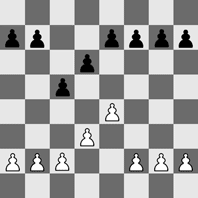 Closed Sicilian formation Closed Sicilian formationOpenings: Primary: Closed Sicilian, Closed English (colors reversed). Character: Closed, complicated position. Themes for White: kingside pawn storm, c2-c3 and d3-d4 break. Themes for Black: queenside pawn storm, a1-h8 diagonal |
Pawn Formations
Bookmark the permalink.
